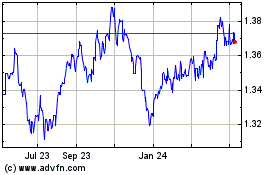U.S. Dollar Advances After Mixed Jobs Data
September 01 2023 - 8:36AM
RTTF2
The U.S. dollar turned higher against its major counterparts in
the New York session on Friday, after falling following the release
of jobs data showing a higher jobless rate and slower wage growth
in August.
Data from the Labor Department showed that the unemployment rate
climbed to 3.8 percent in August from 3.5 percent in July.
Economists had expected the unemployment rate to remain
unchanged.
Non-farm payroll employment climbed by 187,000 jobs in August
compared to economist estimates for the addition of 170,000
jobs.
Revised data showed employment rose by 105,000 jobs in June and
by 157,000 jobs in July, reflecting a combined downward revision of
110,000 jobs.
Annual wage growth slowed to 4.3 percent in August from 4.4
percent in July.
The odds for a Fed rate hike in November or December decreased
to 36.5% and 31.9%, respectively.
The greenback climbed to 3-day highs of 0.8853 against the
franc, 1.0794 against the euro and 1.2607 against the pound, from
its early lows of 0.8794, 1.0882 and 1.2712, respectively. The
currency is seen facing resistance around 0.90 against the franc,
1.06 against the euro and 1.24 against the pound.
The greenback rose to 146.17 against the yen and 0.5943 against
the kiwi, off its early 3-week lows of 144.43 and 0.6015,
respectively. The currency may challenge resistance around 147.00
against the yen and 0.57 against the kiwi.
The greenback appreciated to a 3-day high of 1.3588 against the
loonie, reversing from an early more than 2-week low of 1.3489.
Next key resistance for the greenback may be located around the
1.37 level.
The greenback hovered at a 3-day high of 0.6446 against the
aussie, up from an early 2-day low of 0.6521. If the currency rises
further, 0.62 is likely seen as its next resistance level.
US Dollar vs CAD (FX:USDCAD)
Forex Chart
From May 2024 to Jun 2024

US Dollar vs CAD (FX:USDCAD)
Forex Chart
From Jun 2023 to Jun 2024
